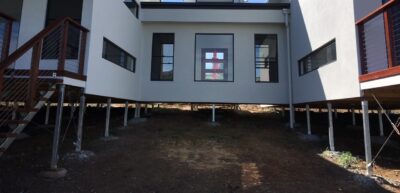Why Foundations Fail (And How to Prevent It)
- Post author:Tom Rooker
- Post published:13/11/2024
- Post category:Blog
A solid foundation is crucial for any raised building, servicing as the backbone that supports everything above it. Unfortunately, foundation failures are not uncommon, leading to costly repairs and significant structural issues.
In this episode, we’ll explore the main reasons foundations fail, signs to watch for, and how to prevent these problems to ensure your structure remains stable and safe.
Why Foundations Fail
Understanding the common causes of foundation failure can help homeowners and builders take proactive measures. Here are some of the common causes:
1. Poor Construction or Design
Neglecting to invest in engineering expertise can lead to design flaws that compromise a building’s structural integrity. Without the oversight of a qualified engineer, builders may overlook critical factors that are essential for a strong foundation. In every case, local authorities will require that professionals design and certify your project..
2. Poor Quality Materials
To ensure a strong and durable foundation, it is crucial to use high-quality materials. Compromising on materials can jeopardize the intergrity of the entire structure. The engineering specifiations outlined above will indicate the required grade and size of materials, and these specifications should be strictly followed by the building contractor.
3. Soil Issues
The condition of the soil beneath your foundation is crucial. Conducting soil tests is essential to ensure that the chosen foundation method is suitable for your local environment and building project. Without a soil test before construction, you risk having unstable ground that may shift over time, leading to cracks or uneven settling in the foundation.
4. Water Damage
Water is one of the most destructive forces for a building’s foundation. Poor drainage, leaks, and flooding can erode soil and weaken the foundation, potentially causing significant damage. It’s important to utilize professional services to assess any potential water inflows that could affect the proposed design.

5. Lack of Maintenance
It is important to conduct regular visual inspections of completed construction projects to identify any changes that may have occurred. Addressing these issues promptly can prevent them from escalating into major concerns. Seeking professional advice early on is advisable to tackle potential problems before they worsen. Additionally, having your building inspected regularly is crucial, as unnoticed deterioration of your foundation can eventually lead to significant failure..
Signs of Failure
Being aware of the signs of foundation failure is crucial for early intervention. Look out for these warning signs:
- Cracks in walls, floors, or ceilings: These can indicate shifting or settling.
- Problems opening and closing doors and windows: Misalignment can suggest foundation movement.
- Uneven floors: Sloping or bouncy floors may signal structural issues.
- Gaps between walls and floors or walls and ceiling: These gaps can indicate that the structure is no longer level.
How to Prevent Failure
Prevention is the best strategy when it comes to solving foundation instability.
One solution is LevelMaster’s adjustable stumps. These stumps feature hot dipped galvanised components to guard against corrosion and allow for adjustments that can accommodate shifting ground or settling over time.
By investing in quality foundation support from the beginning, you can mitigate many of the issues that lead to failure.

Conclusion
Foundation failures can result from a variety of factors, including improper installation, soil issues, and poor construction. Recognising the signs of failure early and implementing preventive measures, such as using LevelMaster’s adjustable stumps, can save you time and money in the long run.
If you’re interested to learn more about how LevelMaster’s adjustable housing stumps can help guard against foundation failure, click here to find out more: https://www.levelmaster.com.au/why-adjustable-house-stumps/.


